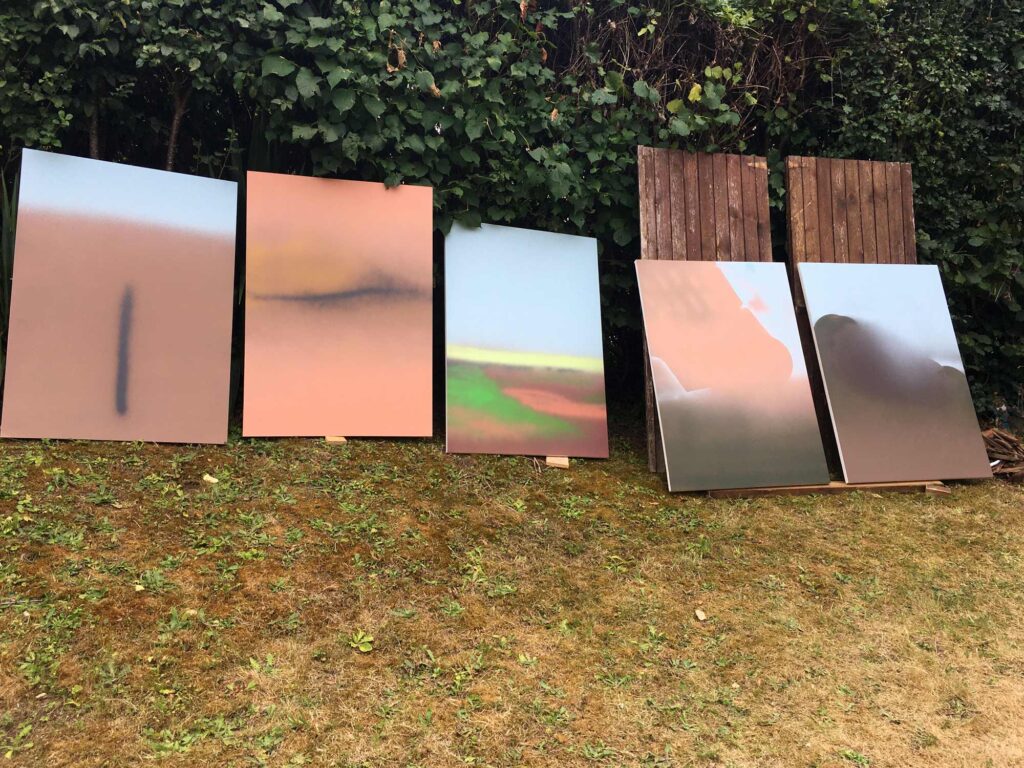Meeting with the artist and the Buddhist master Dahan
Residency in Moganshan (China)
As part of the Harmony Art Exchange programme organised by Harmony Art Gallery in Shanghai from 12 April to 12 June 2019, on 8 April, the Moganshan and Shanghai residency projects went ahead as planned with the four artists: Stephen Doyle (Ireland), Jeongkeun Lee (Korea), J. Jie Li (USA) and David Antonio Loureiro (France). The artists travelled to Moganshan, Huzhou, Zhejiang Province, and spent four days in the temple and workshop of Master Dahan.
In the tranquility of Moganshan, I harvested the fruit of Chinese and Western artistic exchanges.

David AL: Are all these works we see in your studio part of the same series?
How do you combine Buddhist ideas with art making?
Dahan: There are about ten different series here, the series of Chinese herbal medicines, Chinese herbal juice, dead wood from ancient trees, flower and fruit seeds, etc. . I use Chinese herbal medicines to bring out the common points of Buddhism treatment: grief and self-help.
David AL: I understand that behind these creations the intention is to convey the Buddhist philosophy, but why do you combine modern materials and industrial colors in your creations with some elements made with natural materials. What is the reason for this choice?
Dahan: I actually paint gold or bright colors in my paintings. I want to direct or subvert the imagination of ordinary people to Buddhism. In Chinese culture, gold represents power and wisdom. In Buddhism, it represents: solemnity and sacred wisdom. On the other hand, it can also be seen as a philosophical reflection in Buddhism – starting from the opposite direction and emphasizing the truth of a thing. I added a seemingly modern material in some works – gold powder and glitter, to allow the viewer to perceive the anti-natural state, and the problem of “man and nature” is put forward. Although most of the works often talk about how to draw and draw, and the last technique is secondary, just follow your heart to choose the right material to use. There is no painting, no one draws: For example, in the Buddhist cloud “Diamond Sutra”: “There should be nowhere to live and have a heart”.
David AL: I have seen works with burn marks. In the West, particularly in reference to the practices of alchemists, fire is used as the element that allows the separation of the elements of matter and then proceeds to rectification. At the same time, this process is accompanied by a new beginning for the experimenter. Do you echo such an idea?
Dahan: Burning, molding and splattering are the three creative techniques I use. Fire is the origin of human civilization, which represents the beginning, but also symbolizes fire in the five elements: the sap of Chinese medicine in the works is also identical to water. In Chinese culture, it is a concept that emphasizes balance, so I want to show the balance between the meeting point of fire and water in my art creation. Mold also plays an important role in my work: in the creation, we have to control the humidity and temperature and dehumidify when we think the mold is perfect and keep the works in the best conditions.
David AL: Regarding the treatment of mold, does it occur naturally on the canvas or do you grow the mold separately and then add it to the work?
Dahan: It’s about changing the material on the canvas. So you need to have enough experience to control the temperature and humidity and to control the mold condition to the ideal form. I have been experimenting with creating with Chinese herbal medicines since 2005. It took me about five years to really master the effects of mold, burning and medicinal substances.
Dahan: I really like your art creations and I feel like I have a special connection to David Antonio Loureiro. Maybe it’s a spiritual connection. In his work, I have seen many catastrophic problems regarding human problems. I would like to know if he is particularly focused on his creations?
David AL: I always start my creations based on a feeling. The feeling is then what I try to convert into a subject and this approach leads to choices for my compositions. I am very sensitive to our conditioning. I painted the prison in Cuba, as a symbol of self-conditioning. I sometimes feel like a prisoner because I have to obey the norms that our society imposes. In any system, it is impossible to do what you really want to do, being completely free. And if one decides not to follow the social norms, the pressure is exerted in oneself by generating a form of guilt which the norm, coming from the outside, keeps feeding.
I asked you why you use fire in your creations because from my point of view fire carries the characteristics of change: the separation of matter, the mixing and the creation of a new state. This symbolism interests me.
I approach painting as the experience of recognizing oneself in a whole. At the beginning I chose to paint to share my vision of the world while being well installed in my certainties, then by dint of painting, I was quickly confronted with the limits of my own questionings. Finally I realize today that it is painting that forms me.
Dahan: Yes, David just said that he feels like a prisoner. I also have this idea. I have a series of “well” works that speak to that feeling. I feel like I’m framed by the frame, which can be a social frame or whatever.
Author: Ting-Hsin Lin for Harmony Art // Editor: Li Qian
